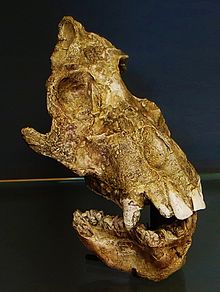Afropithecus
| Afropithecus Temporal range: Miocene
| |
|---|---|

| |
| Skull cast | |
| Scientific classification | |
| Domain: | Eukaryota |
| Kingdom: | Animalia |
| Phylum: | Chordata |
| Class: | Mammalia |
| Order: | Primates |
| Suborder: | Haplorhini |
| Infraorder: | Simiiformes |
| Superfamily: | Hominoidea |
| Family: | †Afropithecidae |
| Genus: | †Afropithecus Leakey & Leakey, 1986 |
| Species: | †A. turkanensis
|
| Binomial name | |
| †Afropithecus turkanensis | |
Afropithecus is a genus of
Morphology
Richard Leakey and Meave Leakey first described Afropithecus turkanensis to be a large hominoid which appeared to have relatively thick enamel.
Cranial morphology
The type specimen, KNM-WT 16999 is composed of a long distinct
From dentition it is known that the palate, which is almost completely calcified, of A. turkanensis is shallow, long and narrow with tooth rows that converge posteriorly, and it is probable the tooth rows were originally nearly parallel. A. turkanensis had a 6.5mm
The thickness of the enamel on the molars is often reported when fossils are being recorded and used to make comparisons across taxa. The thickness is referred to either as "thin" or "thick" and is commonly assessed as a linear measurement of the enamel on worn or naturally fractured teeth. From enamel testing it has been suggested that A. turkanensis is the oldest known thick-enamelled hominoid, which is what would distinguish it from Kenyapithecus.[4]
Post-cranial morphology
Post cranial remains such as KNM-WK 16901, includes an associated right fibula (lacking the proximal portion, and is approximately the same size as Pan troglodytes; 184 mm), a right proximal third
Other post-cranial remains include: KNM-WK 17016P a large right ulna, and foot or hand bones: KNM-WK 17008, KNM-WK 18395.[1]
Feeding
Morphological analysis of the teeth and palate of Afropithecus suggests that it utilized a sclerocarpic foraging diet similar to members of Pitheciidae, in contrast to that of Morotopithecus.[5]
See also
References
- Patel BA, Grossman A (November 2006). "Dental metric comparisons of Morotopithecus and Afropithecus: implications for the validity of the genus Morotopithecus". J. Hum. Evol. 51 (5): 506–12. PMID 16914180.
